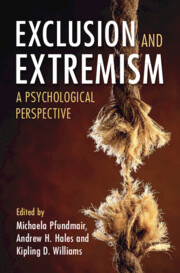Book contents
- Exclusion and Extremism
- Exclusion and Extremism
- Copyright page
- Dedication
- Contents
- Contributors
- Introduction
- Part I The Link between Exclusion and Extremism
- 1 Ostracism and Extremism
- 2 Exclusion and Radicalization
- 3 In the Realm of Action
- 4 Seeking the Self in the Extreme
- 5 Buying the Blackpill
- Part II Drivers of the Exclusion–Extremism Link
- Part III Topics Related to the Exclusion–Extremism Link
- Index
- References
4 - Seeking the Self in the Extreme
White Extremism, Exclusion, and Threat to Self
from Part I - The Link between Exclusion and Extremism
Published online by Cambridge University Press: 16 May 2024
- Exclusion and Extremism
- Exclusion and Extremism
- Copyright page
- Dedication
- Contents
- Contributors
- Introduction
- Part I The Link between Exclusion and Extremism
- 1 Ostracism and Extremism
- 2 Exclusion and Radicalization
- 3 In the Realm of Action
- 4 Seeking the Self in the Extreme
- 5 Buying the Blackpill
- Part II Drivers of the Exclusion–Extremism Link
- Part III Topics Related to the Exclusion–Extremism Link
- Index
- References
Summary
White extremism has been a rising trend in North American and European countries over the past two decades. Despite the systemically engrained privileged status of people who identify as white in US society, one of the causes of white extremism is a perceived threat of being sidelined/disadvantaged by individuals with non-white identities. For example, the mainstreaming of the great replacement theory among right-wing media outlets and politicians demonstrates this perception. We examine this perception, and white extremism rhetoric and radicalization broadly, within the context of social exclusion at both the individual and systemic levels. We further embed this analysis within theories and research focused on concepts of “the self,” social identity, and related psychological needs usually impacted by social exclusion. We recommend researchers and practitioners interested in extremism and radicalization to intentionally consider self-related theories and constructs going forward.
Keywords
- Type
- Chapter
- Information
- Exclusion and ExtremismA Psychological Perspective, pp. 74 - 96Publisher: Cambridge University PressPrint publication year: 2024



